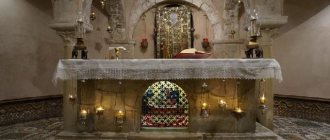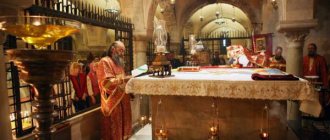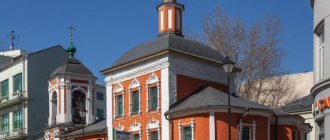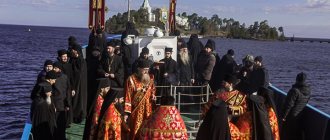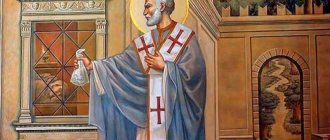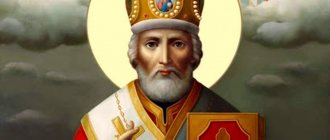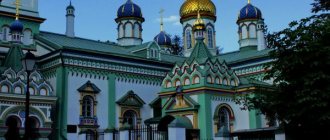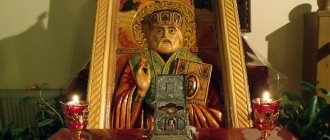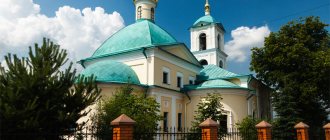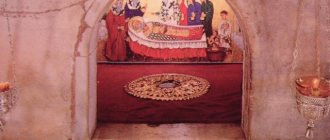Send your friends a ray of light from sunny Italy 
- 28
Shared
The city of Bari, the second most important city in southern Italy after Naples, is located on the heel of the Italian boot. Bari is the capital of the Apulia region, a major seaport and transport hub.
But if Bari had been just another port city, it would not have gained fame far beyond the borders of Italy and would not have become a place of pilgrimage for thousands of Christian believers. It is here that the relics of St. Nicholas the Wonderworker are located - one of the most revered saints among both Orthodox and Catholics.
Excursions in Bari and the surrounding area with Russian-speaking guides. To order =>, +7 910 476-34-33 (WhatsApp)
Relics of St. Nicholas
The small town of Bari in southern Italy is well known to Christians around the world. The relics of St. Nicholas the Wonderworker rest here. The widespread people's love for him is associated with his active participation in people's lives. Evidence of this is the many miracles that happened through the prayers of St. Nicholas.
The relics of St. Nicholas the Wonderworker are one of the proofs of the holiness of the Pleasant of God. The relics are imperishable (that is, not subject to decomposition) bones that secrete a healing liquid - myrrh.
Basilica of St. Nicholas the Wonderworker in Bari (Italy), where the relics of the Saint are kept
“God Himself gives honor, and great honor, even to the bones of saints, for we know that the holy body of the great Saint Nicholas was not preserved incorruptible, only his bones were preserved, which now rest in Bari, exuding healing myrrh.
What does it mean that God Himself honors even the bones of His great saints, does not leave them without attention and protects them when they are threatened with desecration? This means that the bones of saints are a great shrine, for only a shrine, only a great shrine can receive honor from God and His care” (St. Luke of Crimea, 1877-1961).
How does the icon of St. Nicholas the Wonderworker help and its meaning?
In the culture of the Middle Ages, the Orthodox face was an extraordinary phenomenon to which the artist tried to introduce a person to the spiritual world and where he helped him find his own path to transformation. Therefore, the significance of the icon of St. Nicholas the Wonderworker for all believers is extremely great.
His face is present in many homes of Orthodox Christians, thereby protecting them from troubles, as well as the need for anything, bringing prosperity to the household and the patronage of the Saint.
The best article for you, go to: Icon of the Mother of God “Consolation and Consolation”
Why do you dream about the icon of St. Nicholas the Wonderworker?
If in his dream a person saw that the divine image came to life and told him some information, then such a dream can be considered prophetic.
As a rule, it is interpreted as a favorable sign, that is, soon, unexpectedly, incredible miracles will begin to happen in the dreamer’s life.
The earthly life of St. Nicholas the Wonderworker
Saint Nicholas was from the city of Patara (Turkey). He lived in the 3-4 centuries. From a young age, the future saint spent whole days in the temple. He spent the night in prayer and reading books. For his high piety, Nicholas was first made a reader in the temple, then elevated to the rank of priest. Later, in the city of Myra, Lycian region, he was ordained a bishop.
In 325, in the city of Nicaea (Asia Minor), Nicholas the Wonderworker was one of the participants in the First Ecumenical Council. There he spoke out against the Arian heresy. Around 345, in old age, the Great Wonderworker peacefully departed to the Lord.
Miracles of St. Nicholas the Pleasant
Even during his earthly life, Nicholas of Myra became famous as a saint. Traditions about the miracles of the Pleasant of God have been preserved to this day. When Saint Nicholas was traveling to Alexandria (Egypt), a strong storm arose at sea during his voyage. One sailor fell from the mast and fell to his death on the deck. Saint Nicholas prayed to the Lord and the sailor came to life.
During the saint's visit to the Holy Places of Palestine, severe famine occurred in his native land. Saint Nicholas appeared to the Italian merchant who equipped the ship with wheat and ordered him to sail to Lycia. When the merchant woke up, he found in his hand three gold coins given to him by the saint. The ship sailed to the indicated place, the residents were saved from hunger.
Transfer of the relics of St. Nicholas
Helping those in need during his earthly life, Saint Nicholas the Pleasant even now does not deprive believers of his help. The Lord preserved his relics (imperishable bones). They are endowed with special miraculous power: to this day, a fragrant liquid flows from them - myrrh. Believers reverently apply it to sore spots. By praying to the Great Wonderworker, they receive healing from the Lord through him.
More than seven hundred years after the death of Saint Nicholas, his relics rested in the city of Myra in the Lycian country. However, these places began to be attacked by infidels. As a result, the temple where the relics rested was destroyed, and the tomb of the saint was left desolate.
There is a Tradition that in 1087 a priest from Bari (Italy) received instructions from Nicholas the Wonderworker in a dream to transfer his relics to this city. Trade ships were equipped, they managed to steal the relics and deliver them to Italy. In Bari, with a large gathering of Christians, the relics were placed in the Church of St. Eustathius. In 1089, the construction of the basilica was completed, where the relics of St. Nicholas the Wonderworker are located to this day.
The Orthodox Church celebrates the transfer of the relics of St. Nicholas on May 22 according to the new style.
How to pray
Orthodox people pray in front of the icon of the Holy Saint or at his relics. Believers have been coming from different parts of the world for several millennia. Whatever request Christians make, they always receive help.
Most often they call on the righteous to:
- Helped children, people who were far from home and in trouble.
- Prosperity came to the house.
- The daughters married successfully.
- St. Pleasant is considered the patron saint of children; people pray to him for wisdom in upbringing and help in their studies.
- The innocently convicted were freed.
- Patronizes sailors and travelers.
People who turn to prayer need to have pure and good thoughts. Then the Miracle Worker helps you survive difficult situations that have happened in life.
You should draw a cross on sore spots with holy oil and pray. As a rule, it must be said, discarding unnecessary thoughts, while standing in front of the icon at home or in the Temple.
You should get up as early as possible and in silence give praise to God’s Pleasant. And prayer words at night calm you down, you can sleep easily and peacefully. If you wish, you can pray as much as your heart desires.
It is important to know: in Russia, a piece of the relics of the great Saint is located in the Danilov Holy Trinity Monastery in Moscow. In St. Petersburg, in the St. Nicholas Cathedral, there is an ancient 17th-century icon of the Wonderworker with a particle of relics.
Prayer then helps when a believer with a pure soul attends church, prays fervently, and lives a Christian life. Many parishioners know by heart the seven types of prayers dedicated to the Saint.
But you don’t need to limit yourself to prayers only. Many more miracles happen after reading the akathist. It contains special words that help you cope with any difficulties.
Many women were able to give birth to long-awaited children by turning to the Saint in prayer. There are people for whom reading the akathist and fervent prayers to the Wonderworker helped them overcome serious illnesses and terrible diseases.
The most “Russian” saint
The earthly life of Nicholas the Wonderworker took place far from the borders of our country. However, this is, without exaggeration, the most “Russian” Orthodox saint. Icons of St. Nicholas the Pleasant rank second in number after the Mother of God. And the name Nikolai is one of the most common. Why is St. Nicholas of Myra so loved by Russians?
The answer is simple: St. Nicholas the Wonderworker does not ignore any sincere prayer. Miracles through prayers to the saint are proof of this. Saint Nicholas of Myra is revered as the patron saint of sailors, travelers, and cattle breeders. People pray to him for a successful marriage, protection from slander, and from unnecessary death. This is a “universal” assistant.
“For a thousand years now, Rus' has professed faith in Christ, and for a thousand years in Rus' the name of St. Nicholas of God has been revered. He came to us at the same time as Orthodoxy; his holy zeal for faith and piety educated the Russian people. Many churches were erected through his prayer and with his name, every church, every house kept the icon of the saint as a shrine, having him as their assistant and patron” (Archimandrite John Krestyankin, 1910-2006).
Description of the icon
Hagiographic icons of Nicholas the Wonderworker depict the deeds of the saint. These images have been known in Rus' since the 13th-14th centuries. At this time, the main groups of subjects take shape: birth and learning to read and write, ordination to the priesthood, help in troubles. Traditionally, the story of the life and deeds of the saint ends with the story of the transfer of the relics of St. Nicholas from Myra in Lycia, devastated by the Turks, to the Italian city of Bari in 1087.
According to Byzantine legend, the oldest icon of Nicholas the Wonderworker was created according to the description of people who saw the saint with their own eyes, therefore the portrait image of Nicholas the Wonderworker in icons is always approximately the same: he is a gray-haired and gray-bearded old man with a high forehead and wise eyes, on whose face lies the imprint of spiritual holiness and firmness in faith.
The divine face is highly revered and therefore it is found in many churches and temples. Let's look at the most famous of them:
- Belt. On this shrine, the miracle worker is depicted waist-deep, holding the Gospel in his left hand and blessing with his right. The saint has as decoration a purple phelonion (a long and wide strip of material with images of crosses, as a sign of bishop’s authority), as well as an omophorion, which represents a kind of likeness to the bishop of the Lord in the patronage of the salvation of the Orthodox people. The left hand of the image is covered with a chasuble and an omophorion, thereby expressing its respect for the Divine Word;
- Nikola Mozhaisky. The saint here is depicted holding a fortress in his left hand and a sword in his right. Such a face personifies the defender of Orthodox cities;
- Rostova. Here the image is depicted with spread arms, reminiscent of Oranta’s pose and having as vestments a brace, a robe and a phelonion with an omophorion and a club visible underneath.
The existing canon of painting the icon of St. Nicholas the Wonderworker preserves this tradition - an aura of holiness and grace truly emanates from his face.
Just one glance at the saint during his lifetime or at the icon of St. Nicholas the Wonderworker brought and continues to bring peace and confidence into the soul in his intercession for everyone who sincerely prays.
The image of the saint was found in the decorations of churches in Byzantium and Ancient Rus'. Here it was placed both individually and in a church composition.
- The right hand of the Pleasant makes a blessing movement, and in his left hand is the Holy Gospel.
- The saint's vestments include a chasuble, a phelonion (sleeveless outer monastic robe) and an omophorion (amice).
- In the structure of most shrines, the viewer observes images of the Virgin Mary and Jesus Christ, placed in oval medallions. The Most Pure Mother and the Son of God return the omophorion (amice) and the Holy Gospel to the venerable elder - objects of bishop's honor.
- Since the 15th century, an icon in honor of “Nicholas of Mozhaisk” has been displayed in Russian churches. It creatively replicates the wooden statue that patronized Mozhaisk.
- The saint was often depicted as a militant defender with a sword in his right hand. Such iconography was borrowed by Russian masters from Romanesque art.
- The image of a holy warrior, averting threats from his homeland, gained great popularity in Rus', which waged continuous wars between the 15th and 16th centuries. The sword symbolized God's Word, cutting through all kinds of sins.
- “Nicholas of Zaraisky” is a famous image where the monk is depicted with outstretched arms. His right hand performs a blessing, and his left hand contains the Gospel. This style of icon is extremely common in Christian art and is called “oranta”.
Most other images of the Wonderworker do not differ fundamentally from those listed above: they fit correctly into traditional iconography. Such images are glorified by miracles and are named after the place where they were found.
Currently, it is believed that the oldest icons of St. Nicholas the Wonderworker in Rus' are the one from Novgorod, dating back to the 14th century, as well as the icon from Kolomna, which is kept in the Tretyakov Gallery. The iconographic image of the saint is so recognizable that even the inscription on the icon of St. Nicholas the Wonderworker with his name is not necessary to understand who is depicted on the icon.
Where are the relics of St. Nicholas the Wonderworker kept?
Now the main part of the relics of St. Nicholas the Wonderworker resides at a five-meter depth in the lower part of the Catholic basilica in the city of Bari. Three stone blocks cover the saint's tomb. Through small holes with a diameter of 6 centimeters, the annual collection of the holy myrrh flowing from the bones of the Pleasant of God takes place.
A small part of the relics is kept on the island of Lido (Venice, Italy).
Reliquaries with particles of the relics of St. Nicholas are found in many churches throughout the Orthodox world. For example, in the monastery in the name of the Great Martyr Panteleimon in the city of Odessa (Ukraine), in the Nikolo-Ugreshsky Monastery (city of Dzerzhinsky, Moscow region), in the church-museum of St. Nicholas in Tolmachi at the Tretyakov Gallery (Moscow).
Current location of the remains
At first, it was planned to choose the local Cathedral as the place for storing the stolen relics.
But then a temple was specially built. Two years later, in 89 of the 11th century, the shrine was placed in an underground chapel in the Basilica. Every year on the same day, the clergy enter the Basilica to collect myrrh. The remains exude it. Myrrh is diluted with holy water. Pilgrims from different parts of the world take it with them. Blessed oil helps in healing people.
In the city of Mira, after the abduction by the Italians, some of the relics still remained. But they were not destined to stay in their homeland. Soon she was kidnapped and taken to Venice. Now the shrine is located in two tombs. That they are genuine has been proven by anthropologist Luigi Martino.
Today the remains of the Saint rest in two different churches with the same name:
- in Bari the main part;
- on the Lido Island in Venice.
Pilgrims try to get to these churches every year to pray to the saint.
Visiting the relics in Russia
In 2022, our country was visited by the relics of St. Nicholas of Myra. This became possible thanks to an agreement between Patriarch Kirill of Moscow and All Rus' and Pope Francis in February 2016. Medical specialists, using special instruments, performed a complex operation to extract part of the relics (left rib) for sending to Russia. The shrine was delivered by a special plane. For the arrival of the relics, Russian jewelers made a 40-kilogram ark from precious metals.
During his two months in Moscow and St. Petersburg, more than two million believers came to venerate the relics of the saint. Many came not only from other cities of Russia, but also from Belarus. Often I had to stand in line for up to 12 hours just to touch the shrine. For many, this was a step towards a new life, life with God.
As Patriarch Kirill noted:
“When venerating the miraculous and multi-healing relics of this great saint of the Lord, we must remember that we are called to be imitators of the virtues of the Myra saint, and the help sent to us through his intercession will be the more obvious and generous, the more we become like him in love for Christ and to all people."
“Saint Father Nicholas, pray to God for us!”
Having reached a very old age, Saint Nicholas peacefully departed to the Lord on December 19 (NS) around the year 345.
The body of the Pleasant of God was laid with honor in the cathedral church of the Mir Metropolis. The relics of Nicholas the Wonderworker were kept incorrupt and exuded healing myrrh, from which many received healings. For this reason, people flocked to his coffin from all over the world. For with that holy world not only physical ailments were healed, but also mental ailments. According to the life of the saint, the relics were in Myra (Myra) in Lycia for several hundred years until they were transferred to Italy.
Transfer of the relics of St. Nicholas the Wonderworker to Bari
More than seven hundred years have passed since the death of the Pleasant of God. The city of Myra and the entire Lycian country were destroyed by the Saracens. The ruins of the temple with the tomb of the saint were in disrepair and were guarded only by a few pious monks.
In 1087, Saint Nicholas appeared in a dream to an Apulian priest of the city of Bari (in southern Italy) and ordered his relics to be transferred to this city.
The presbyters and noble townspeople equipped three ships for this purpose and, under the guise of traders, set off. This precaution was necessary in order to lull the vigilance of the Venetians, who, having learned about the preparations of the inhabitants of Bari, had the intention of getting ahead of them and bringing the relics of the saint to their city.
The nobles, taking a roundabout route through Egypt and Palestine, visiting ports and conducting trade as simple merchants, finally arrived in the Lycian land. The scouts sent reported that there were no guards at the tomb and it was guarded only by four old monks. The barians came to Myra, where, not knowing the exact location of the tomb, they tried to bribe the monks by offering them three hundred gold coins, but due to their refusal, they used force: they tied up the monks and, under the threat of torture, forced one faint-hearted person to show them the location of the tomb.
Broken tomb of St. Nicholas in Myra Lycia
The journey lasted twenty days, and on May 9 (May 22, new style) they arrived in Bari. A solemn meeting was arranged for the great shrine with the participation of numerous clergy and the entire population. Initially, the relics of the saint were placed in the church of St. Eustathius.
The celebration of the transfer of the shrine was accompanied by numerous miraculous healings of the sick, which aroused even greater reverence for the great saint of God. Two years later, the lower part (crypts) of the new temple was completed and consecrated in the name of St. Nicholas, built deliberately to store his relics, where they were solemnly transferred by Pope Urban II on October 1, 1089.
May 22 is the day of the transfer of the relics of St. Nicholas the Wonderworker
The transfer of the relics of Nicholas the Wonderworker from Myra Lycia to Bari aroused special veneration of the saint and was marked by the establishment of a special holiday on May 22. At first, the feast of the transfer of the relics of St. Nicholas was celebrated only by residents of the Italian city of Bari. The Greek Church, for example, did not establish a celebration of this memory, because the loss of the relics of the saint was a sad event for it.
The Russian Orthodox Church established the commemoration of the transfer of the relics of Nicholas shortly after 1087 on the basis of deep veneration of the great saint of God. The glory of the miracles performed by the saint on land and sea was widely known. His image of the omnipotent Wonderworker-philanthropist became especially dear to the heart of an Orthodox person, because he instilled deep faith in him and hope for his help.
Where are the relics of St. Nicholas now?
Relics of St. St. Nicholas the Wonderworker in the Basilica of Bari, Italy
To this day, the honest relics of Nicholas the Wonderworker exude blessed myrrh, giving physical and spiritual healing to thousands of Christians from all over the world. Once a year, on the day of the transfer of the relics to Bari, the priests collect the myrrh exuded by the relics. Diluted with holy water, it is then transported by pilgrims to different countries so that Orthodox believers in different parts of the world can receive spiritual and physical healing from the consecrated oil.
Relics of St. Nicholas in Venice
Relics of St. Nicholas the Wonderworker on the island. Lido, Venice
For several years, the inhabitants of the island of Lido and Bari waged fierce disputes over the relics of St. Nicholas. Some claimed that the real relics were kept in the Lido, others - that in Bari. They were judged by their examination, which proved that in both cases there is truth. Most of the relics are kept in Bari, and only one fifth in the Lido.
Every year, churches are visited by a huge number of pilgrims from all over the world, eager to venerate the highly revered shrine and offer prayers to St. Nicholas the Pleasant.
The meaning of Nicholas the Wonderworker in Christian culture
Nicholas the Wonderworker, also called St. Nicholas the Saint, lived in the 4th century in Asia Minor (now the territory of Turkey). He was a priest and then became the archbishop of the city of Myra in Lycia. In church traditions there is evidence of numerous miracles that the saint performed. Christians believe that Nicholas the Wonderworker still helps people. He is considered one of the patrons of travelers; in addition, St. Nicholas is one of the most revered Christian saints.
According to the church calendar, celebrations in his honor are held twice a year: December 19, the day of his death, and May 22, in memory of the transfer of the relics from Myra in Lycia to the city of Bar, which is now called Bari.
The saint was originally buried in the Church of Holy Zion, where he served, in the city of Myra in the confederation of ancient Lycia (now the city of Demre in Turkey). In May 1087, Italian merchants stole most of the relics of the saint and transported them to Bari.
Since 1969, Catholics have allowed Orthodox Christians to hold services in the crypt of the Basilica of St. Nicholas in Bari according to their rites. After these services, which take place every week on Thursdays, everyone can venerate the relics through a special window in the marble altar.
In Russia, the veneration of St. Nicholas the Wonderworker is very widespread, and the number of churches and icons dedicated to him was the largest after the Virgin Mary. His name was one of the most popular in Russia for naming babies until the beginning of the 20th century.
The decision to deliver the relics of St. Nicholas the Wonderworker from Bari to Russia
The relics of St. Nicholas the Wonderworker have never left the papal basilica in the Italian city of Bari for 930 years. An exception was made only for our country. The relics are kept under the altar altar of the crypt - walled up underground. Every year hundreds of believers from Russia came to Bari to venerate the saint.
An agreement on the delivery of part of the relics of the saint was reached at a historic meeting between Patriarch Kirill and Pope Francis in Havana on February 12, 2016. Patriarch Kirill said that for the majority of Orthodox Christians in Russia, pilgrimages to Italy are difficult to implement. Therefore, it was decided to remove part of the relics (the left rib) from under the cover to send to Russia. The process of separating part of the relics was carried out by medical specialists using special devices.
How long will the relics of St. Nicholas the Wonderworker remain on Russian territory?
Bringing part of the relics of St. Nicholas from Italy - from May 21 to July 28. The relics will be located in Moscow in the Cathedral of Christ the Savior. You can venerate the relics on May 22 from 12:00 to 21:00. And from May 23 to July 12, pilgrims will have access from 8:00 to 21:00. The queue to the Cathedral of Christ the Savior will form from the Crimean Bridge. Volunteers will give water to the believers, and the authorities have decided to install food service points along the line. In July the relics will be transported to St. Petersburg.
The bringing of the relics is timed to coincide with the saint’s memorial day. It was decided to greet the ark with the relics with a festive ringing in churches throughout Moscow.
Delivery is carried out by a special board. And at the jewelry factory, in time for the arrival of the relics, they made a 40-kilogram ark from precious metals. In addition, for the bringing of the relics in Russia, an icon was painted with the face of St. Nicholas the Wonderworker. It was created by icon painter Olga Zhukova.
All information about the bringing of the relics of St. Nicholas the Wonderworker to Russia can be found on a specially created website.
At whose expense will the relics of St. Nicholas the Wonderworker be delivered to Russia?
The Russian and the Guryev family personally took upon themselves the financing of the delivery of the relics of St. Nicholas the Saint to Russia and their sending back to Bari.
PhosAgro is one of the world's leading producers of phosphorus-containing fertilizers. Its general director is Andrey Guryev. This company has always paid for charters for Russian pilgrims to the relics of the saint twice a year. Participation in the delivery of the relics to Russia was a continuation of this good cause, said priest Alexander Volkov, press secretary of Patriarch Kirill of Moscow and All Rus'.
Miracles
Orthodox believe that St. Nicholas is considered the patron saint of travelers. According to church traditions, he performed many of his miracles while traveling by ship to Palestine, where he went to worship the local saints. Nicholas showed the gift of foresight; he warned the sailors about the impending storm. When a storm hit, Saint Nicholas calmed the team and turned to God in prayer - the elements subsided without causing any trouble.
During the journey, Nicholas the Wonderworker resurrected one of the sailors who died after slipping on the deck. The young man came to life after prayer.
During stops along the coast, the saint healed people physically and spiritually: he drove out evil spirits, healed them from illnesses, and gave them consolation in sorrows.
According to church tradition, Nicholas the Wonderworker saved his native people in the Lycian country, where famine was raging. Before sailing, the merchant saw the saint in a dream, who ordered him to sail to Lycia and gave him a deposit - three gold coins. Waking up, the merchant actually found money in his hand and fulfilled the will of the saint.
In 1956, an event took place in Kuibyshev (today Samara) that is now known as “Zoya’s Standing”. According to legend, during the New Year celebration, the girl Zoya, without waiting for her groom, took the icon of St. Nicholas the Wonderworker from the wall and began to dance with it with the words: “If there is a God, let him punish me.” Suddenly she froze in place with the icon pressed to her chest; they could not move her. This went on for a long time, but before the Feast of the Annunciation, a handsome old man found himself in a house where a girl was standing. He turned to Zoya with the words: “Well, are you tired of standing?” And when the guards looked into the room, they did not see him there. The girl stood motionless for 128 days, then the petrification began to pass - at this time she asked everyone to pray for peace and prayed herself.
Christians believe that St. Nicholas the Saint still helps believers. It is believed that myrrh (fragrant oil for sacred anointing) of St. Nicholas the Wonderworker can heal from many diseases, including cancer. Parishioners also believe that prayer to St. Nicholas saves you from smoking and alcoholism, helps you find a job, pay off debts, avoid getting lost in another country, and even get pregnant.
The miraculous image of St. Nicholas of Mozhaisk is considered evidence of the mercy of Nicholas the Wonderworker towards Russia. During the siege of Mozhaisk by the Mongols, a sign appeared in the sky. Saint Nicholas, as the legend says, appeared in the sky above the cathedral, in one hand he held a sword, and in the other - an image of the temple surrounded by a fortress. This frightened the enemies and instilled courage in the city's defenders. After this, an image of the saint was created in gratitude for his help.
The relics of St. Nicholas the Wonderworker are a source of healing
Moscow resident Larisa suffered from pyelonephritis and cystitis for more than 30 years since childhood. Drug treatment did not provide a complete cure. Having visited the city of Bari (Italy) on a pilgrimage trip in 2012, she earnestly prayed to St. Nicholas the Wonderworker at his relics. Returning home, she underwent the planned operation. After this, the disease did not return, she was completely cured.
Tamara lived in Antalya (Turkey), near the city of Demre (formerly the city of Myra in Lycia). For a long time she was a beer alcoholic. Finding herself dependent on passion, she could not overcome it on her own. However, realizing the destructiveness of the vice, the woman prayed daily to St. Nicholas the Pleasant. One day, together with a pilgrim group, she came to the temple of the city of Demre, where the relics of St. Nicholas the Wonderworker had previously rested. Having made a tearful prayer to the saint, she returned home. The next day she lost the desire to drink beer. Soon she met her other half, got married, and gave birth to a son.
A resident of the capital, M., suffered from poor eyesight for 30 years and had to wear contact lenses. When the relics of St. Nicholas were brought to Moscow in 2022, she hastened to venerate the shrine. She had to stand in line for more than 8 hours. After venerating the relics, the woman returned home. When she was watching TV in the evening, she felt a sharp pain in her eyes. Her vision deteriorated greatly, so much so that she almost stopped seeing anything. Fearing complete loss of vision, the woman took off her lenses. Imagine her surprise when she realized that she no longer needed them. Her vision was restored, but the lenses simply got in the way.
Second prayer to Nicholas the Wonderworker
Oh, great intercessor, to the bishop of God, the Most Blessed Nicholas, who shone with sunflower miracles, appearing as a quick hearer to those who call upon you, who always precede them and save them, and deliver them, and take them away from all sorts of troubles, from these God-given miracles and gifts of grace! Hear me, unworthy, calling you with faith and bringing you prayer songs; I offer you an intercessor to plead with Christ.
Oh, renowned for miracles, saint of heights! as if you have the boldness, soon stand before the Lady, and reverently stretch out your hands in prayer to Him for me, a sinner, and grant me the bounty of goodness from Him, and accept me into your intercession, and deliver me from all troubles and evils, from the invasion of enemies visible and invisible freeing, and destroying all those slander and malice, and reflecting those who fight me throughout my life; for my sins, ask for forgiveness, and present me saved to Christ and be worthy to receive the Kingdom of Heaven for the abundance of that love for mankind, to which belongs all glory, honor and worship, with his beginningless Father, and with the Most Holy and Good and Life-giving Spirit, now and ever and unto ages centuries. Amen.
Troparion
The rule of faith and the image of meekness and abstinence as a teacher show you to your flock as the truth of things: for this reason you have acquired high humility, rich in poverty. Father Hierarch Nicholas, pray to Christ God to save our souls.
Kontakion
In Mireh, the holy, the priest appeared: For Christ, O Reverend, having fulfilled the Gospel, you laid down your soul for your people, and saved the innocent from death; For this reason you have been sanctified, as the great hidden place of God’s grace.
In which temples is the miraculous face located?
Since there are a huge number of lists of this icon, we will tell you about the location of some of them:
- In the Cathedral of Christ the Savior in Moscow there is a Holy Image, which was painted in Bari, where the Basilica of St. Nicholas was built;
- The revered image of St. Nicholas in the Life on Presnya in the Church of the Nativity of John the Baptist, however, a face with a similar plot can be seen on Peski in the Church of the Transfiguration;
- In Elekhov there is another miraculous image of the Saint. The cathedral contains particles of relics and a list depicting St. Nikola, VMC. Barbara and St. Basil the Great;
- You can see the Kolpino face of the Wonderworker in the Church of the Holy Trinity “Kulich and Easter” in St. Petersburg.
The best article for you, go to: The Pochaevskaya Icon of the Mother of God, what it helps with, what it protects from
And this is how you should read prayers to the Wonderworker
Prayer 1
“Oh, all-holy Nicholas, exceedingly saintly servant of the Lord, our warm intercessor, and everywhere in sorrow a quick helper! Help me, a sinner and sad person in this present life, beg the Lord God to grant me forgiveness of all my sins, which I have sinned greatly from my youth, in all my life, in deed, word, thought and all my feelings; and at the end of my soul, help me the accursed, beg the Lord God, the Creator of all creation, to deliver me from airy ordeals and eternal torment: may I always glorify the Father and the Son and the Holy Spirit, and your merciful intercession, now and ever and unto ages of ages. Amen".
Prayer 2
“Oh, all-validated, great wonderworker, Saint of Christ, Father Nicholas! We pray to you, awaken the hope of all Christians, protector of the faithful, feeder of the hungry, joy of the weeping, doctor of the sick, steward of those floating on the sea, feeder of the poor and orphans, and quick helper and patron of all, may we live a peaceful life here and may we be worthy to see the glory of God’s elect in heaven , and with them unceasingly sing the praises of the one worshiped God in the Trinity forever and ever. Amen".
God bless you!
